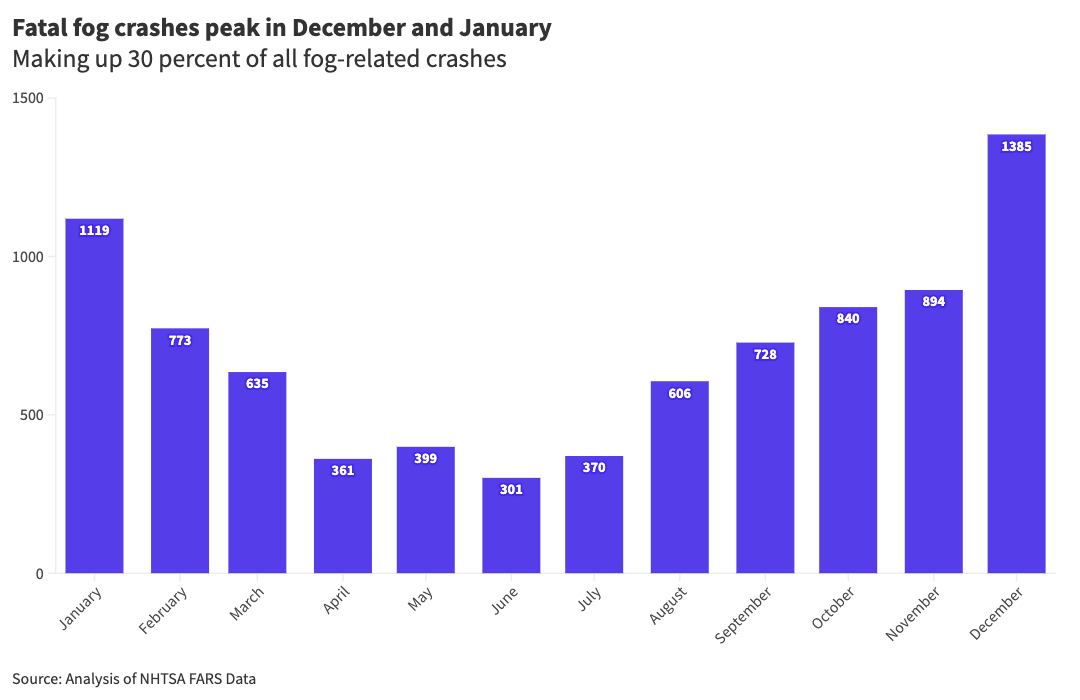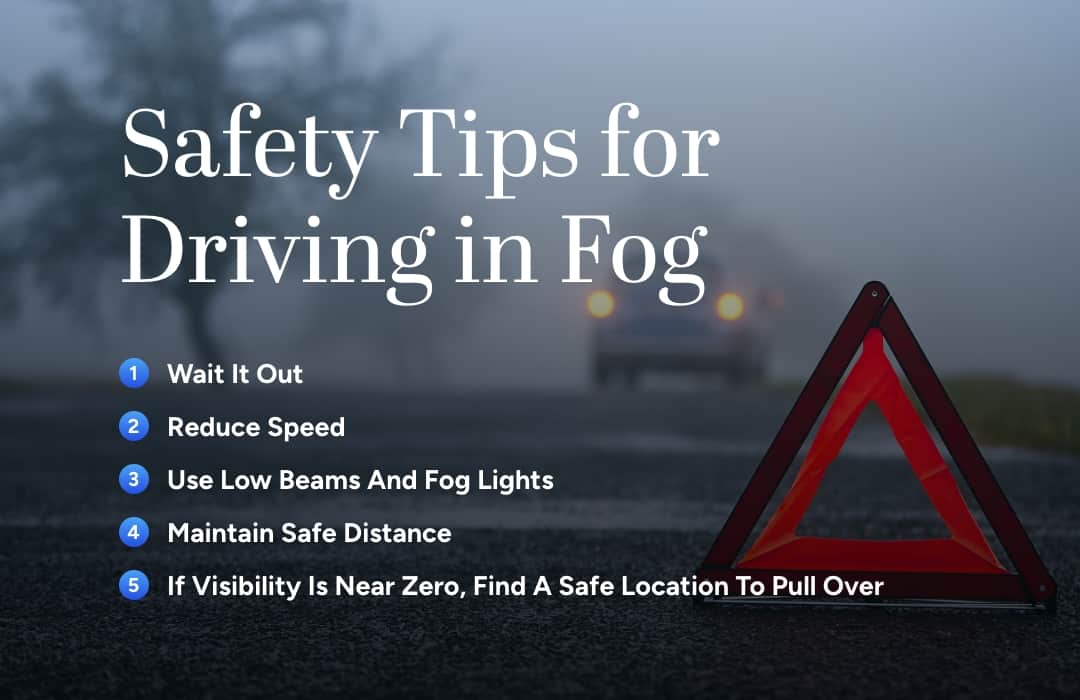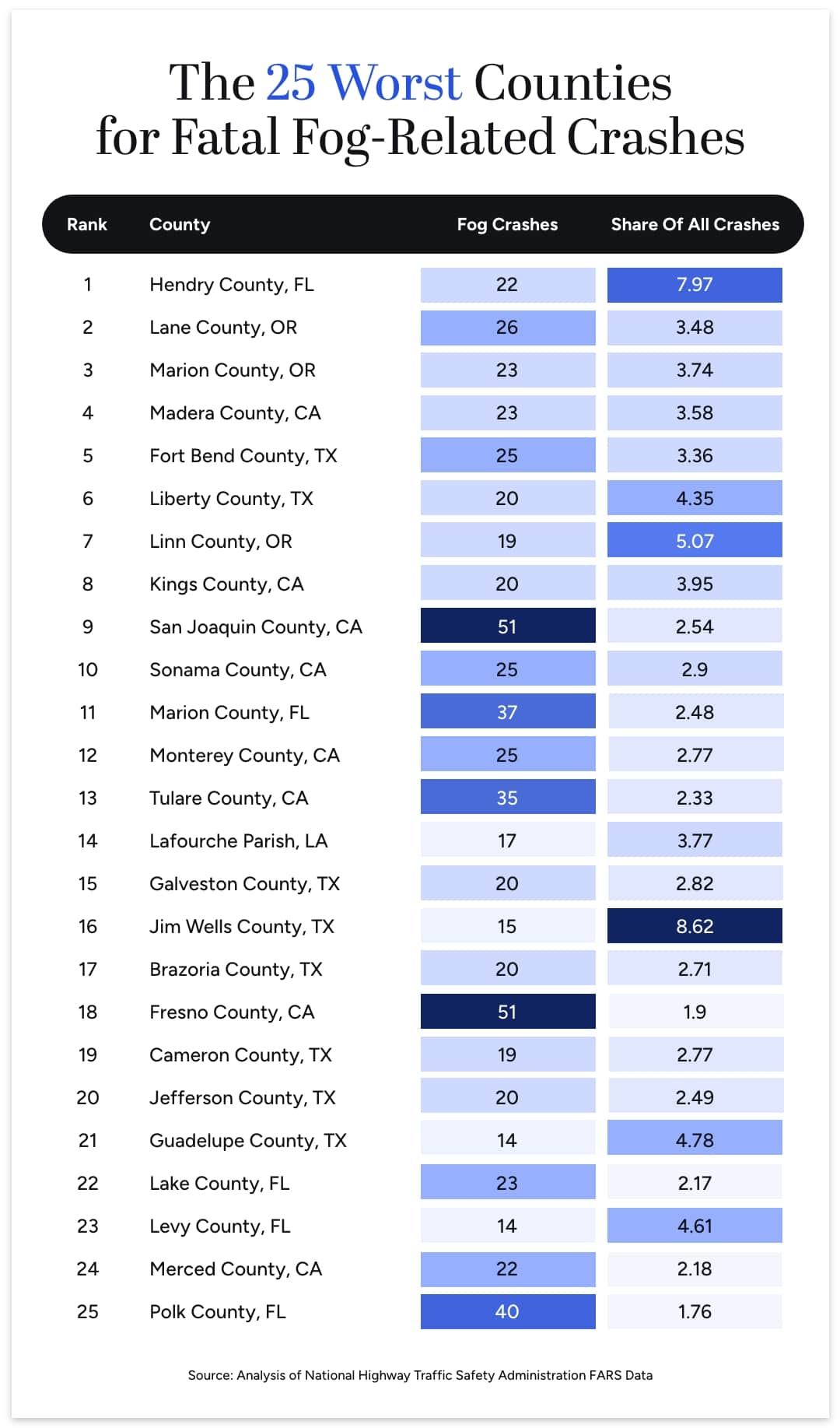
On October 23rd, 2023, an unusually dense combination of smoke and fog shrouded the New Orleans area, creating dangerous driving conditions on many Louisiana roads. The “super fog” eventually led to a devastating 158-vehicle chain-reaction crash on Interstate 55 that killed eight people.
Just days later, super fog blanketed the area again and caused another deadly crash on Interstate 10.
While super fog is a relatively rare weather phenomenon, fog that impacts visibility and safety on the road is not – especially during the late fall and winter months. From 2001 – 2021, there were a total of 8,410 fatal crashes on U.S. roadways when fog was present – nearly 30 percent of which occurred in December and January.
When and where do fog-related fatal crashes occur most often? How can drivers keep themselves and other motorists safe?
Hill Law Firm analyzed over 700,000 fatal crash records from the National Highway Traffic Safety Administration (NHTSA) to find the answers.
Key Findings
- During the observation period, foggy conditions were only present in a little over one percent of all fatal collisions. However, that rate nearly doubled (2.2 percent) in December and January, accounting for 2,504 of the 8,410 fog-related crashes.
- They are more likely to occur during early morning hours – with 38 percent between the hours of 5 and 8 am.
- While fog-related fatal crashes are most common in Texas (971) and California (755), they are most prevalent in West Virginia and Oregon.
- More fog-related fatal crashes happen on California State Route 99 than any other road or highway in the country, with 43 crashes that killed 53 people.
- Crashes in these conditions are more likely to be in rural areas. In fact, 64 percent of fatal crashes in foggy conditions occurred on rural roads, compared to 44 percent for all other fatal crashes.
When Do These Crashes Occur?
Fatal fog crashes are most likely to occur in the early morning hour – peaking between 5 am and 8 am. While fog typically forms overnight, the morning rush hour period exposes many more motorists to dangerous conditions.
While the foggiest times of year vary from region to region, December and January are the deadliest months by far. In fact, 30 percent of all fatal fog crashes occur during these two months and the rate of fog-related crashes increases by nearly double.

Where Do These Crashes Occur?
Any time fog develops and impacts visibility, it creates a potentially dangerous road condition. However, some roads, counties, and states see more fog and fatal crashes than others.
By Roadway
During the observation period, eight roadways saw 20 or more fatal fog crashes. Three of those roads were in California, two in both Texas and Florida, and one in Louisiana.
- SR-99 in California: 43 crashes
- I-10 in Texas: 32 crashes
- US-101 in California: 32 crashes
- US-27 in Florida: 31 crashes
- I-75 in Florida: 31 crashes
- I-5 in California: 26 crashes
- US-59 in Texas: 21 crashes
- I-10 in Louisiana: 20 crashes
The 25 Worst Counties
The worst county in the United States for fog-related fatal crashes was Hendry County, Florida. Here, nearly eight percent of all fatal crashes (22 in total) occurred in foggy conditions.
Rounding out the top five were Lane and Marion Counties in Oregon, Madera County in California, and Fort Bend County in Texas.
Interestingly, five counties in California’s Central Valley (Madera, Kings, San Joaquin, Fresno, and Merced) appear in the top 25. This region is notorious for a special kind of dense fog, called “tule” (TOO-lee) fog, during winter. This fog can be so thick that it is often visible on satellite. It should come as no surprise, then, that CA SR-99, the road where the most fog-related crashes occurred during the observation period, runs right through the Central Valley.
Which States Have the Deadliest Fog?
Which states have the deadliest fog? Hill Law Firm ranked them by the total number of fatal fog crashes and the percentage of all fatal collisions that involved fog.
#1: Louisiana
289 Fog Crashes
Fog Crash Rank: #6
Share of all Crashes: 1.81 percent
Fog Share Rank: #5
#2: Texas
971 Fog Crashes
Fog Crash Rank: #1
Share of all Crashes: 1.44 percent
Fog Share Rank: #10
#3: Washington
213 Fog Crashes
Fog Crash Rank: #12
Share of all Crashes: 2.02 percent
Fog Share Rank: #3
#4: Oregon
206 Fog Crashes
Fog Crash Rank: #15
Share of all Crashes: 2.48 percent
Fog Share Rank: #2
#5: Pennsylvania
343 Fog Crashes
Fog Crash Rank: #4
Share of all Crashes: 1.33 percent
Fog Share Rank: #14
#6: Missouri
261 Fog Crashes
Fog Crash Rank: #9
Share of all Crashes: 1.41 percent
Fog Share Rank: #12
#7: West Virginia
165 Fog Crashes
Fog Crash Rank: #21
Share of all Crashes: 2.53 percent
Fog Share Rank: #1
#8: Wisconsin
204 Fog Crashes
Fog Crash Rank: #16
Share of all Crashes: 1.65 percent
Fog Share Rank: #7
#9: North Carolina
341 Fog Crashes
Fog Crash Rank: #5
Share of all Crashes: 1.22 percent
Fog Share Rank: #20
#10: Illinois
269 Fog Crashes
Fog Crash Rank: #8
Share of all Crashes: 1.24 percent
Fog Share Rank: #19
#11: Florida
659 Fog Crashes
Fog Crash Rank: #3
Share of all Crashes: 1.14 percent
Fog Share Rank: #24
#12: Indiana
207 Fog Crashes
Fog Crash Rank: #14
Share of all Crashes: 1.29 percent
Fog Share Rank: #16
#13: California
755 Fog Crashes
Fog Crash Rank: #2
Share of all Crashes: 1.08 percent
Fog Share Rank: #28
#14: Alabama
227 Fog Crashes
Fog Crash Rank: #10
Share of all Crashes: 1.22 percent
Fog Share Rank: #21
#15: Minnesota
141 Fog Crashes
Fog Crash Rank: #25
Share of all Crashes: 1.62 percent
Fog Share Rank: #8
#16: Kentucky
199 Fog Crashes
Fog Crash Rank: #18
Share of all Crashes: 1.28 percent
Fog Share Rank: #17
#17: Arkansas
149 Fog Crashes
Fog Crash Rank: #23
Share of all Crashes: 1.33 percent
Fog Share Rank: #15
#18: Georgia
285 Fog Crashes
Fog Crash Rank: #7
Share of all Crashes: 0.99 percent
Fog Share Rank: #32
#19: Maine
55 Fog Crashes
Fog Crash Rank: #34
Share of all Crashes: 1.72 percent
Fog Share Rank: #6
#20: Nebraska
67 Fog Crashes
Fog Crash Rank: #31
Share of all Crashes: 1.52 percent
Fog Share Rank: #9
#21: South Carolina
208 Fog Crashes
Fog Crash Rank: #13
Share of all Crashes: 1.1 percent
Fog Share Rank: #27
#22: Iowa
100 Fog Crashes
Fog Crash Rank: #28
Share of all Crashes: 1.4 percent
Fog Share Rank: #13
#23: North Dakota
43 Fog Crashes
Fog Crash Rank: #38
Share of all Crashes: 1.96 percent
Fog Share Rank: #4
#24: Tennessee
215 Fog Crashes
Fog Crash Rank: #11
Share of all Crashes: 1 percent
Fog Share Rank: #31
#25: Oklahoma
148 Fog Crashes
Fog Crash Rank: #24
Share of all Crashes: 1.12 percent
Fog Share Rank: #25
#26: Michigan
202 Fog Crashes
Fog Crash Rank: #17
Share of all Crashes: 0.99 percent
Fog Share Rank: #33
#27: Idaho
56 Fog Crashes
Fog Crash Rank: #33
Share of all Crashes: 1.26 percent
Fog Share Rank: #18
#28: Kansas
96 Fog Crashes
Fog Crash Rank: #29
Share of all Crashes: 1.21 percent
Fog Share Rank: #22
#29: Vermont
19 Fog Crashes
Fog Crash Rank: #45
Share of all Crashes: 1.43 percent
Fog Share Rank: #11
#30: Virginia
150 Fog Crashes
Fog Crash Rank: #22
Share of all Crashes: 0.91 percent
Fog Share Rank: #38
#31: Ohio
193 Fog Crashes
Fog Crash Rank: #19
Share of all Crashes: 0.85 percent
Fog Share Rank: #41
#32: South Dakota
32 Fog Crashes
Fog Crash Rank: #39
Share of all Crashes: 1.18 percent
Fog Share Rank: #23
#33: Mississippi
132 Fog Crashes
Fog Crash Rank: #26
Share of all Crashes: 0.94 percent
Fog Share Rank: #36
#34: Montana
47 Fog Crashes
Fog Crash Rank: #37
Share of all Crashes: 1.12 percent
Fog Share Rank: #26
#35: New York
181 Fog Crashes
Fog Crash Rank: #20
Share of all Crashes: 0.75 percent
Fog Share Rank: #43
#36: New Jersey
115 Fog Crashes
Fog Crash Rank: #27
Share of all Crashes: 0.92 percent
Fog Share Rank: #37
#37: Connecticut
55 Fog Crashes
Fog Crash Rank: #35
Share of all Crashes: 0.98 percent
Fog Share Rank: #34
#38: Maryland
96 Fog Crashes
Fog Crash Rank: #30
Share of all Crashes: 0.88 percent
Fog Share Rank: #40
#39: Rhode Island
15 Fog Crashes
Fog Crash Rank: #48
Share of all Crashes: 1.08 percent
Fog Share Rank: #29
#40: New Hampshire
23 Fog Crashes
Fog Crash Rank: #43
Share of all Crashes: 0.95 percent
Fog Share Rank: #35
#41: Colorado
59 Fog Crashes
Fog Crash Rank: #32
Share of all Crashes: 0.53 percent
Fog Share Rank: #46
#42: Alaska
15 Fog Crashes
Fog Crash Rank: #49
Share of all Crashes: 1.07 percent
Fog Share Rank: #30
#43: Massachusetts
54 Fog Crashes
Fog Crash Rank: #36
Share of all Crashes: 0.7 percent
Fog Share Rank: #44
#44: Wyoming
24 Fog Crashes
Fog Crash Rank: #42
Share of all Crashes: 0.91 percent
Fog Share Rank: #39
#45: Utah
32 Fog Crashes
Fog Crash Rank: #40
Share of all Crashes: 0.63 percent
Fog Share Rank: #45
#46: Delaware
19 Fog Crashes
Fog Crash Rank: #46
Share of all Crashes: 0.81 percent
Fog Share Rank: #42
#47: New Mexico
29 Fog Crashes
Fog Crash Rank: #41
Share of all Crashes: 0.39 percent
Fog Share Rank: #47
#48: Nevada
20 Fog Crashes
Fog Crash Rank: #44
Share of all Crashes: 0.32 percent
Fog Share Rank: #48
#49: Arizona
17 Fog Crashes
Fog Crash Rank: #47
Share of all Crashes: 0.09 percent
Fog Share Rank: #51
#50: Hawaii
7 Fog Crashes
Fog Crash Rank: #50
Share of all Crashes: 0.31 percent
Fog Share Rank: #49
#51: District of Columbia
2 Fog Crashes
Fog Crash Rank: #51
Share of all Crashes: 0.29 percent
Fog Share Rank: #50
Safety Tips When You Encounter Fog
If you have ever encountered dense fog while driving, you understand how deeply it can affect your ability to see around your vehicle. While it can be an intense and even harrowing situation, understanding what to do can go a long way toward avoiding a serious car accident.

The best thing you can do when fog sets in is to wait it out. If possible, don’t drive until the fog lifts. However, if you must drive in foggy conditions, some general safety tips are:
- Turn on fog lights and low-beam headlights.
- Never use high-beam lights. High beams cause glare and can make it much more difficult for you the road in front of you.
- Reduce your vehicle speed and allow for extra time to reach your destination.
- Maintain a safe distance from lead vehicles, increasing your following distance to give you enough time to react.
- Use roadside reflectors on the right side to keep from entering other lanes and as a guide around curves.
- If visibility is near zero, pull over into a safe location such as a business or parking lot. If such a location is unavailable, pull your vehicle as far off of the road as possible and turn off all lights except for hazards.
Data and Methodology
This analysis is based on fatal collision data provided by the National Highway Traffic Safety Administration for the years 2001-2021. While the data indicates whether or not fog was present in each crash, it does not indicate the level to which it affected overall visibility. For more information on this study, please contact Hill Law Firm.

